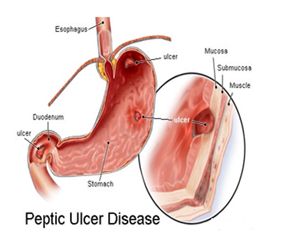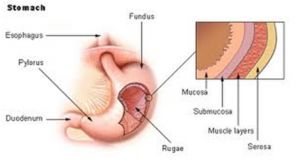Stomach Surgery
The biggest organ in the digestive tract is the stomach. It is located higher than common belief, under the lower ribs and not in the vicinity of the navel. It is a muscular sac that lies between the esophagus and the upper small intestine. Digestion of food starts here. Starch hydrolyzes, fat digests, hydrochloric acid cleans it, proteins are changed, and acids start the digestive process here. The stomach is even a temperature regulator. We can, however, live without the stomach. Stomach surgery is most often required either due to or stomach ulcers or stomach cancer.
Conditions Treated
Stomach Ulcer (Peptic Ulcer Disease)
Stomach Tumors (benign and malignant)
Stomach Cancer
Stomach Ulcers
 An ulcer is literally a sore – a localized erosion of mucous membranes. An ulcer can result from infection, inflammation, or cancer. Certain foods, beverages, and substances like smoking, alcohol, caffeine, and aspirin can irritate the stomach and irritate ulcers.
An ulcer is literally a sore – a localized erosion of mucous membranes. An ulcer can result from infection, inflammation, or cancer. Certain foods, beverages, and substances like smoking, alcohol, caffeine, and aspirin can irritate the stomach and irritate ulcers.
Non-surgical treatments for ulcers can include medicines that can reduce the amount of stomach acid and lessen the irritation of an ulcer. Bleeding from an ulcer can be stopped using endoscopic therapy.
When medicine and endoscopy cannot control an ulcer, surgery is often the last resort to remove the damaged part of the stomach wall. The goal is to remove as little of the stomach as possible.
Stomach Cancer
 The most common malignant tumor of the stomach is a carcinoma, although several other types are possible. The majority of stomach cancers begin in the innermost layer of the stomach lining, the mucosa.
The most common malignant tumor of the stomach is a carcinoma, although several other types are possible. The majority of stomach cancers begin in the innermost layer of the stomach lining, the mucosa.
Cancer occurs when the cells of the stomach lining begin to divide and grow out of control, causing one or more tumors. If left untreated, cancer destroys the lining and spreads to another part of the body. Early detection is important, but early stomach cancer has few symptoms.
Some symptoms of advanced stomach cancer are:
- discomfort in the abdominal region
- black, tarry stools
- vomiting after meals or the vomiting of blood
- weakness
- fatigue
- weight loss
- feeling abnormally full after a meal
When stomach cancer is detected early and not too widespread, cancer can sometimes be removed using endoscopy. The endoscope is a long tube that is inserted into the patient’s mouth and esophagus and then into the stomach. The surgeon performs the surgery to remove the stomach cancer through the tube, seeing his way with a tiny TV camera inserted into the tube.
When stomach cancer is more developed, the cancer is generally treated by surgically removing part or all of the stomach (called a partial or total gastrectomy). After a partial gastrectomy, the remaining portion of the stomach is reconnected to the esophagus and small intestine. After a full gastrectomy, the esophagus is attached directly to the small intestine. Sometimes completely removing the entire stomach is the only sure way to stop stomach cancer.
Radiation and chemotherapy may be used also with stomach removal or as an alternative.
Getting Back to Normal
Since this is a major operation, the following surgery you will need post-operative care for your comfort and nutrition.
- One can expect to live a normal life after partial or complete stomach removal.
- If the whole stomach is removed Vitamin B12 shots will be necessary to prevent anemia.
- Ongoing dietary modification may be indicated:
- Eating smaller meals.
- Eating more frequent meals.
- Avoiding a high intake of fat at any given time.
- Making sure that the calories you take in are as nutritious as possible.
- Utilizing dietary supplements if you are having difficulty maintaining good nutrition.
